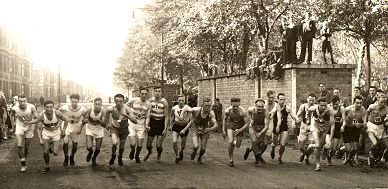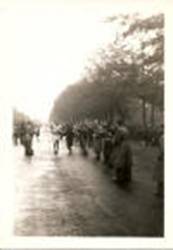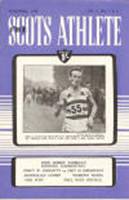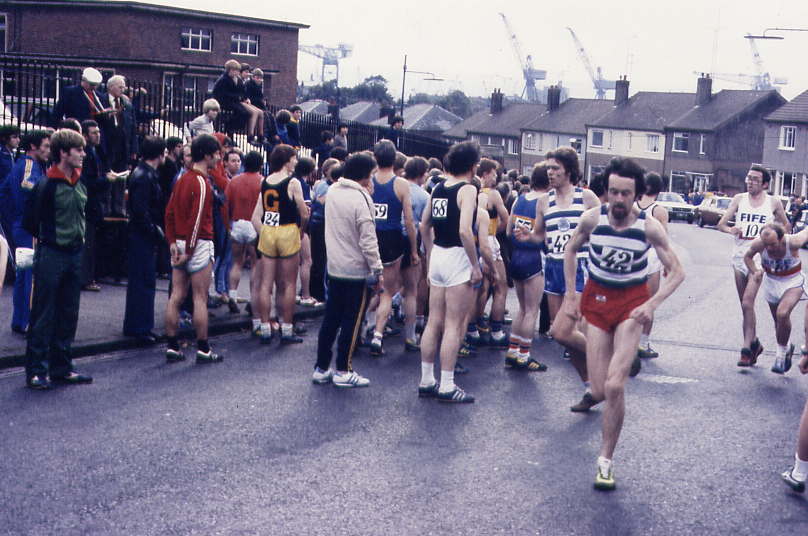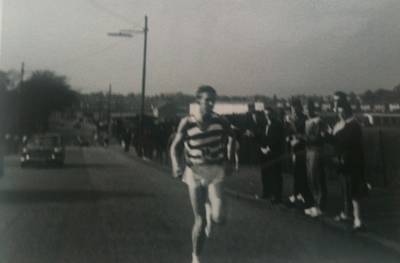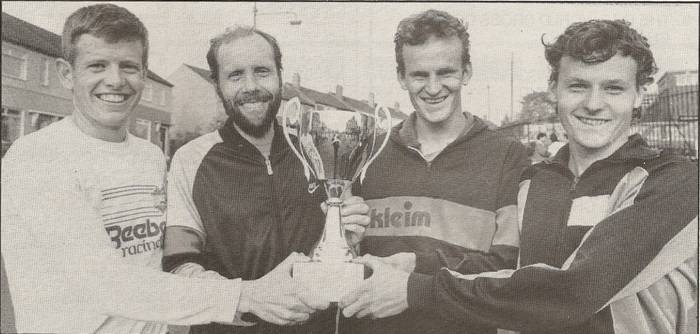McAndrew start in 1950
The McAndrews’ were always the genuine start of the winter season – regardless of whether other races were run before it. As you jogged round the trail before the race you met friends that you hadn’t seen since the National Cross-Country in March. Those in that category had their legs scrutinised to see how fit they were – the ones with white legs were clearly not fit. And that tells its own tale – who would dare to be seen jogging round the trail without tracksters, trackie bottoms or tights these days? And, come to that, who would train on the roads without tights in 2012? Nevertheless all the top runners turned up at the McAndrew Relay – maybe one of the reasons for the success of Scottish endurance running was the head to head races of all the very best athletes over the years, with the added incentove of trying to beat their own time of last year or even to have a go at the best times of the past. An excellent race.
The McAndrew Relays started up in 1934 and are still (2013) going strong. Organised by Victoria Park AAC at the west end of Glasgow they have done what few, if any, clubs have managed in altering a race trail quite dramatically and keeping it popular. That it was a classic is never in doubt, whether it remains so is down to the committee over the next few years. The original course started at Victoria Park Drive on the south side of Victoria Park with the race headquarters being in the Whiteinch Baths. It started in the middle of the long straight and the runners headed east until they got to Balshagray Drive when they turned right and along the east side of the park before turning right again at Queen Victoria Drive North and heading along the north side of the Park. Reaching the corner of Westland Drive (there’s a roundabout there now) it was right turn up Westland Driver before turning left into Westbrae Drive after passing Thomas Aquinas School. Left at the end of the short road over the railway line and follow Southbrae Drive all the way to Anniesland Road before turning left again into Queen Victoria Drive North. Over the hill and along Danes Drive and past Scotstoun Showground, then right into Westland Drive for a bit before left again into the finishing straight along Victoria Park Drive. It was basically two squares touching each other at the corner of Victoria Park Drive North and Westland Drive. there were no testing hills but a couple of long straights which made for a fast trail and one which was enjoyed by all. It was approximately three and a quarter miles long.
McAndrew Relay 1950: Finish (A Forbes)
The inaugural race was held in season 1934-35 and the first four teams were Garscube Harriers, Plebian Harriers, Greenock Glenpark Harriers and Eglinton Harriers. Some unfamiliar names there but little did any of those running realise that the McAndrew memorial race would continue into the twenty first century. The following years resulted in victories for Plebian Harriers (1935) and Shettleston Harriers (1936 and 1937). It was even held in war-time: the Shettleston harriers club history says that it was the only open race held in the first four months of the war and it was also run in 1940-41 and by 1944-45 it was again a regular fixture on the cross country scene. Shettleston won again in 1945 and in 1946 Maryhill Harriers were victorious with Emmet Farrel being the fastest man in 16:00. In 1947, Shettleston Harriers won with Victoria Park runner Andy Forbes fastest in 15:52. 1948 saw Motherwell YMCA victorious in 65:48 from Bellahouston Harriers and the Motherwell man Jim Fleming set a new record of 15:37 – two seconds faster than the existing record set by Willie Donaldson of Shettleston pre-war. Then came a whole series of Victoria Park victories by their all-conquering road racing teams of the 1950’s when they were virtually unbeatable. They won in 1949 (fastest man Andy Forbes in 15:47) and 1950 (fastest man Tommy Tracey of Springburn in 15:42), 1951 (Fastest man Eddie Bannon of Shettleston in 15:20.) This last was a fascinating race in that Tommy Tracey (Springburn) set a new course record of 15:23 on the third stage and then Bannon broke the new record on the last leg with his 15:20. Victoria Park won again in 1952 but Shettleston Harriers were second and third teams with A Black of Dundee Thistle Harriers the fastest man.
Ian Binnie
Victoria Park won again in 1953 with Ian Binnie setting a new course record of 15:01. In 1954 Shettleston won by 12 seconds from Victoria Park whose Ian Binnie had the fastest time and a new record with a superb 14:48. Victoria Park were back in winning form again in 1955 from Shettleston Harriers and Binnie again had the best time of the day with 15:02 from Andy Brown’s 15:03. It was again Victoria Park in 1956 with Binnie recording 14:53 for fastest time. In 1957 the double was repeated for the third consecutive year when the host club won again with Binnie having the fastest run of the afternoon. The ninth win in ten years came in 1958 before Shettleston – their closest rivals all through the 50’s – won in 1959 with the excellent time of 62:21 and again in 1960 with the slightly slower time of 62:48. Although host club Victoria Park and Shettleston Harriers dominated the race up to this point and for many years thereafter, Motherwell YMCA led by Andy Brown and with such talents as his brother Alex, John Linaker, Ian McCafferty and Bert MacKay, won almost everything on the road for several years and took first place in the McAndrew Relays in 1961, 1962, 1963 and 1964.
The course had to be altered when the Clyde Tunnel was built at the beginning of the 60’s, and the motorway was built along the south side of the park. Two alternative courses were tried thereafter before the second well known course was introduced. It was inevitable that there would be cries of “It’ll never be the same” and with two false starts it seemed the merchants of doom would be proved right. But with the new trail allied to the old date and the tradition, it was business as usual after 1964. The thumbnail below is the VPAAC team which won in 1965l: Iain McPherson, Albert Smith, Hugh Barrow and Joe Reilly
The new trail started in Westbrae Drive outside the gates of St Thomas Aquinas School which was the race headquarters. Up to Westbrae and over the railway bridge but unlike the previous trail, this one turned right and headed for Crow Road. Up Crow Road to Anniesland Road, a long fast stretch followed all the way to Queen Victoria Drive North, over the hill to Danes Drive and back up to the change-over at the top of Danes Drive. Shorter than the previous course at just under three miles it was also a very fast course, it was first run in 1964. Each trail lasted long enough for the results to build up over a long period and it was possible for the runners to compare themselves with runners of past decades. Given its slot in the calendar – always the first Saturday in October – it signalled the start of the winter season and it was possible to pick out the unfit runners by their white legs! No training in tracksuit bottoms or leggings in these days. Real runners had brown legs! It had started at a time when there were only County Relays (and even then not for every county) and District Relays and they were very popular. Many clubs started the season by staging their own McAndrew trial to pick the team. It was probably the best supported relay of them all with teams from the east and north joining all the central belt clubs. This pre-eminence in the minds of endurance athletes and their clubs has lasted until the present day although the Kilbarchan AC George Cummings Relay has started to make slight inroads since this course has ceased to be used.
McAndrew 1979 – Alastair Douglas hands over to Des Austin
Victoria Park won in 1965 and 1966 and for the remainder of the 60’s and most of the 70’s the race was dominated by Shettleston. They won it in 1967, 1968, 1970, 1971, 1972, 1976, 1977 and 1979. There is a reason for everything and the club had been blessed with a number of really top flight athletes such as Lachie Stewart, Lawrie Spence, Alistair Blamire, Dick Wedlock and many others. The new trail lasted until the end of the century and became a classic trail with its own list of best times, racing dramas and controversies in its own right. (EAC won in 1974 and ESH in 1975).
In the middle of this winning streak, there was an event that was to affect the McAndrew seriously in a few more years time. In 1974 the Scottish Cross Country Unions started a National 4 man Cross-Country Relay Championship to be run over two and a half miles. It was won that first year by the short lived Clyde Valley AAC and was probably a race whose time had come, but it had significance for the future of the McAndrew Relay. The winter season after the War had begun with two road relays – the Dundee Kingsway and the McAndrew – then after a week there were two cross country relays – the County Championships and the District Championships. Although both road relays had the top clubs and individuals competing at the sharp end, the McAndrew had the bigger field and had been in existence longer. It was unofficially recognised as the start of the season. Many clubs had their own McAndrew Trial race run either the Saturday before or the Tuesday before to help select teams. The Kingsway Relay had been defunct for a number of years by 1974 and October now had a format of the McAndrew on the first Saturday, the County Relay on the second Saturday followed by the District and then National Championships. A National Championship always has a higher priority for clubs than any other and with four races in as many weeks, runners had to decide which they were doing. To my mind, four short relays in consecutive weeks is not too much to ask of any endurance runner but as time passed attitudes to racing changed. For instance to many athlete and coaches the progression from County to District to National Relays represented a kind of natural progression in intensity. The National governing body however decided that having the County and National on successive weekends was to ask too much of the athletes and the Counties were run on the second Saturday which meant that the local championship had to switch to the third. Although the McAndrew kept its cachet for many years to come there has been a steady drop off in the number of clubs and club teams competing. There are other factors at work, but introducing the National Championships did the McAndrew no favours! The ‘Running Boom’ of the late 70’s and through the 80’s gave the race, as it did to all races of the time, a fillip in terms of numbers but it disguised the gradual decline in importance of the race.
Hugh Barrow (VPAAC) running the last stage for the winning team in the fastest time of the day in 1965
If the 50’s and 60’s had been largely the Victoria Park years, and Shettleston dominated the 70’s, then the 80’s were the most open decade so far with several teams taking the honours. In 1981, Falkirk Victoria won the race from exactly 100 teams for the very first time. Similarly in 1983 the new club of Spango Valley won for the first time after being led off by Lachie Stewart who had joined the new club as a veteran with Lawrie Spence, brother Cammie and Chris Leck making up the squad. Winners in 1984 were Bellahouston Harriers who had been a major force in the great years of the 50’s with Victoria Park and Shettleston. Edinburgh Southern Harriers added a touch of the East when they won in 1985. In 1986 Spango Valley won again with Lawrie Spence, Chris Robison and the Connaghan brothers making up the team. Peter Fleming of Bellahouston Harriers had the fastest time of 15:07. They took it again in 1987 with Nat Muir of Shettleston taking the best time award with 15:02. In 1988 Greenock Glenpark Harriers won the race with Alan Puckrin being fastest man with the outstanding time of 14:54. In 1989 it was Falkirk Victoria’s victory with Victoria Park’s Alastair Douglas having the fastest time of 15:03. Steve Ovett came up from England to live in Scotland and run for Annan & District AAC and he was in their team for the 1990 race and recorded the fastest time of 14:49, a new record, in the race which was won by Dundee Hawkhill Harriers.
Spange Valley (126) were winners in 1986: Chris Robison, Lawrie Spence, Stephen and Peter Connaghan
The course had been altered again because of road alterations at Anniesland Cross in 1986 to one that was a bit shorter and the staff at ‘Scotland’s Runner devised a formula for comparing times on the two trails! I think they were joking but for posterity they told us that times on the ‘old’ course should be multiplied by 1.117 to find out what a comparable time on the new course should be! Thus, they said, a time of 13:30 on the old trail would be worth 15:05 on the new trail.
With the formation of Edinburgh Racing Club (later to turn out under a variety of names as their sponsor changed , they were variously Reebok RC, Leslie Deans RC, Mizuno RC and at the very end Favorit RC), the pattern for the 90’s was set. there has been a series of ‘teams of champions’ in Scotland from Dunky Wright’s Caledonia AC in the 20’s via the women’s Western LAC in the 60’s to Racing Club and of these Racing Club was the most successful on the road although Western would challenge their supremacy on the track – and probably win. However it may be, Racing Club were to win the McAndrew Relay in 1991, 1992, 1993, 1995, 1996, 1997, 1998, 2000, 2001, 2002 and 2003 before they became defunct in 2003. Shettleston was the only club to break the sequence with victories in 1994 and 1999. Recruiting athletes from all over the country with no youth policy or women’s teams, their only ambition was to win things and they said the intention was to build a team to do Scotland credit by being able to challenge the top teams South of the Border. The result was that they ruined many events as races with the result almost always being a foregone conclusion.
No pattern has emerged since their demise – in their last run in the event, they were behind the Clydesdale Harriers team until Glen Stewart caught and passed Clydesdale’s Graeme Reid on the final stage. Their main challengers during their brief existence however was Shettleston Harriers: note their two wins in the McAndrew in the 90’s. No pattern has emerged on the latest course since the demise of Racing Club with a variety of winners although Shettleston did win it for three consecutive years from 2007 to 2009. Winners since 2003 have been Ronhill Cambuslang Harriers (2004), Inverclyde AC (2006), Shettleston Harriers (2007, 2008 and 2009) and Glasgow University Hares and Hounds in 2010.
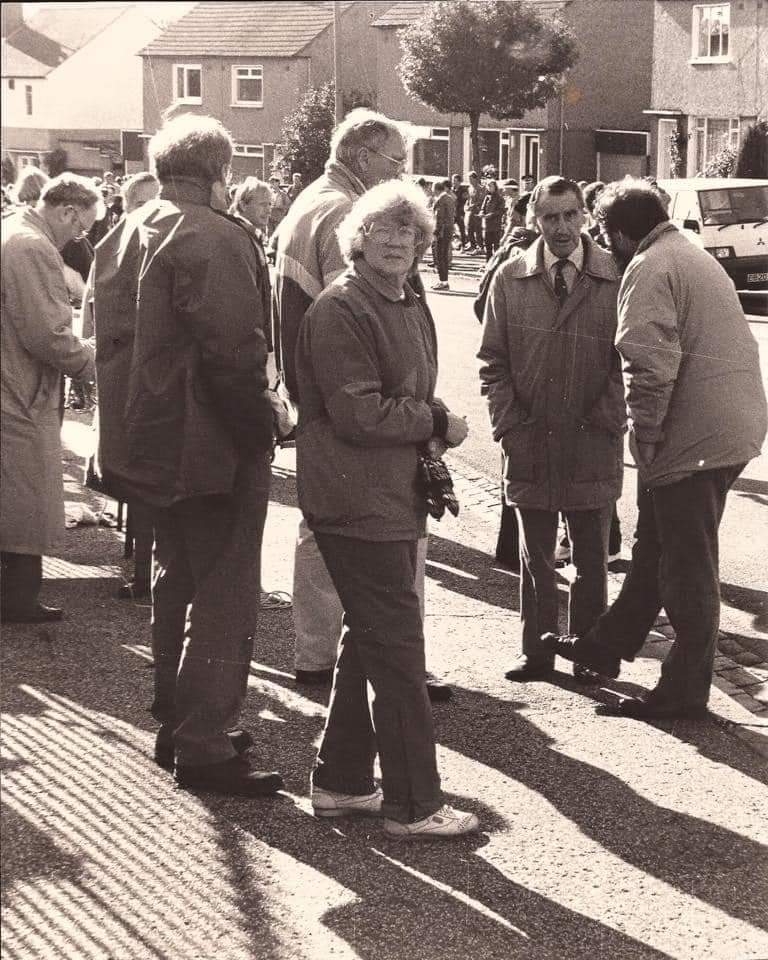 McAndrew start/finish. On the right, top journalist Doug Gillon interviews the great Andy Forbes. Molly Wilmoth looks at camera, with husband Danny behind her.
McAndrew start/finish. On the right, top journalist Doug Gillon interviews the great Andy Forbes. Molly Wilmoth looks at camera, with husband Danny behind her.
There are some results from the 1960’s and some personal memories of the races via the McAndrew Personals links below.
Some McAndrew Results McAndrew Personals McAndrew Relay in Pictures
